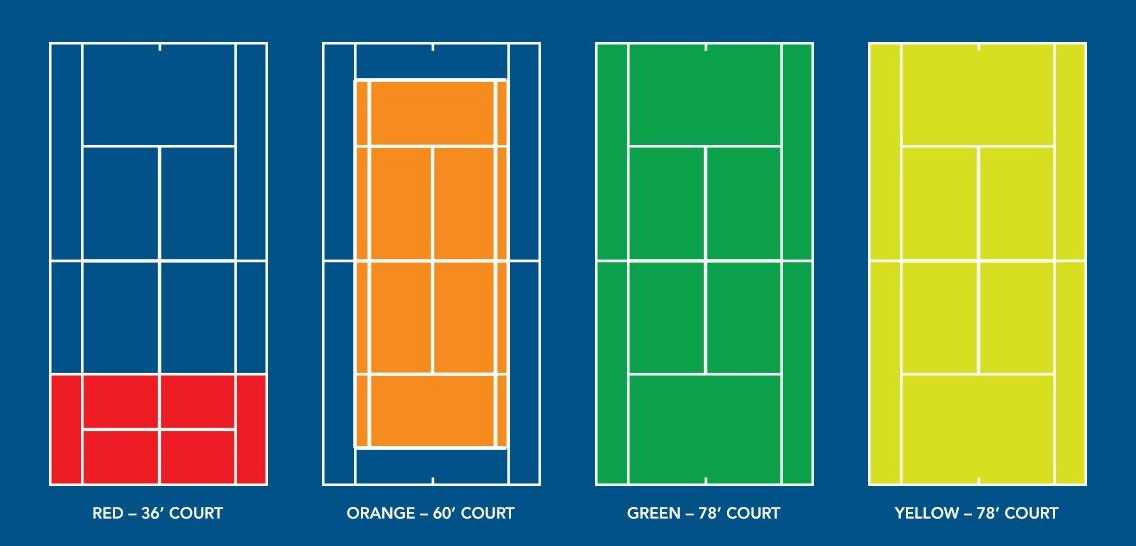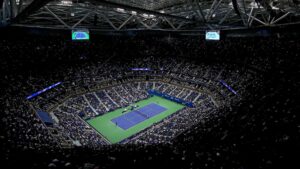If you are already interested in playing tennis or have kids who practice the sport, chances are you stumbled across ROGY tennis and probably thought “what’s this and why should I care?“
ROGY in tennis refers to a developmental pathway for young players, using different types of balls and court sizes to match their age and skill level. The acronym ROGY stands for Red, Orange, Green, and Yellow, which are the colors of the balls used in this progression:
- Red Ball: This is the first stage, suitable for children aged 8 and under. The red ball is larger, softer, and bounces lower than standard tennis balls, making it easier for young children to hit. Matches are played on smaller courts with shorter rackets.
- Orange Ball: Designed for children aged 8-10. The orange ball is softer and bounces lower than a yellow ball but higher than a red ball. The court is bigger than the red ball court but still smaller than a full-sized tennis court.
- Green Ball: This stage is for children aged 9-10. The green ball is slightly softer and has a lower bounce than the standard yellow ball. It’s used on a full-sized tennis court, helping players transition to the standard game.
- Yellow Ball: This is the standard tennis ball used by players aged 11 and older, including adults. It’s used on a full-sized court and represents the final stage in the ROGY progression.
This system is designed to make learning tennis fun and accessible for children, allowing them to develop skills and confidence before moving on to the next level. By gradually increasing the difficulty, young players can better adapt to the game’s physical and technical demands.
Table of Contents
What are the main benefits of using red, yellow and green balls for junior player development?
Using Red, Orange, Green, and Yellow (ROGY) balls in junior tennis player development offers several key benefits:
- Easier Skill Development: The different ball types are tailored to the physical abilities and skill levels of young players. Red, orange, and green balls are softer, slower, and have a lower bounce compared to standard yellow balls. This makes it easier for children to hit the ball, learn proper stroke techniques, and develop their skills.
- Enhanced Learning Experience: The lower compression and slower speed of these balls give players more time to react and position themselves. This helps in improving their footwork, anticipation, and overall understanding of the game.
- Reduced Physical Strain: Young players are less likely to experience strain or injury using these balls, as they require less physical strength to play. This is particularly important for children whose muscles and joints are still developing.
- Increased Confidence and Enjoyment: Success is easier to achieve with these modified balls, which can boost confidence and enjoyment. When children experience success and have fun, they are more likely to stay engaged and continue playing and improving.
- Progressive Development: Each color represents a different stage of development, allowing children to progress at their own pace. As they grow and improve, they move on to balls that are closer to the standard yellow tennis ball, preparing them for competitive play.
- Tactical Development: The slower speed of the balls allows young players to learn and implement various tactics and strategies in their game, which might be difficult to execute with the standard ball due to its faster pace.
- Adaptability to Different Court Sizes: Especially for red and orange balls, the game can be played on smaller courts. This is more suitable for younger children, making the game more accessible and manageable.
- Longer Rallies: The slower pace of the balls often leads to longer rallies, which is beneficial for improving endurance, concentration, and overall match-play skills.
Overall, the ROGY system is designed to facilitate a smoother transition into the sport of tennis, making it more accessible and enjoyable for children, and laying a solid foundation for their future development in the sport.
Some kids feel comfortable playing “up”, to larger court-size and high-bounce balls (regular ones), but in most cases we need to understand their physical limitations and have their safety in mind.
A 5-year-old should not use an adult size racquet, nor play full-court, no matter how talented and eager. Chances of injuries are high, the player won’t enjoy high-bounce balls and being made to run all over the court, without any chance to actually properly rally.



[…] moving up to 26″ as soon as she hit the Green Ball stage (read more about ROGY Tennis Development Pathway), my daughter struggled with the larger racket. It was a clear example of rushing into something […]